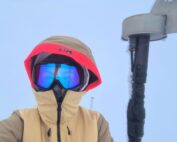Measuring Snow On The Summit
2014-03-13 17:22:41.000 – Mike Dorfman, Weather Observer
NULL
Just over a foot of snow fell on the summit over the past 36 hours, drifting into some really impressive piles around the summit building. As you may know, we measure precipitation every six hours here at the Observatory, measuring the depth in a can approximately 100 feet away from the summit building. On a clear summer day, collecting the precipitation can is an extremely simple task (usually), but last night, Observer Ryan Knapp encountered drifts ranging from waist to chest deep.
We’ve used the same method for collecting precipitation for much of our history. We measure our precipitation every six hours, simply measuring the depth of snow or water in a can exposed to the precipitation outside. Surrounding this can, there is a piece of metal in the rough shape of an inverted cone called a Nipher Snow Gauge. This helps minimize the turbulence above the can in strong winds, helping to reduce the amount of snow that drifts into the can. Even with this additional protection, observers have to be very careful to make sure the amount of snow that is collected in the can seems valid. Even with the most advanced instruments, measuring snow in windy environments has proven extremely difficult. The problem lies in the fact that on mountaintops, snowfall direction is governed much more on wind than gravity.
Snow measurement is critical for several reasons here on the summit. We strive to be as accurate as possible to help the National Weather Service constantly improve their models. Differences between observations and model output for a specific time help the models better train themselves for future events, in turn helping us forecast more accurately. The amount of snowfall recorded on the summit will then indicate how deep the snowpack is by the spring and therefore how much runoff should be expected downstream when it melts. Lastly, it is an indicator, utilized by the Mount Washington Avalanche Center, to predict what the avalanche danger may be around the mountain, helping keep the public safe.
Whether or not you like snow, I hope everyone has successfully dug out there driveways and shoveled their sidewalks! With the added winds today, we will continue to work on the regenerating 5-foot drifts in the entranceway up here on the summit! Wish us luck!
Mike Dorfman, Weather Observer
Supporter Spotlight: Ryan Shepard
Supporter Spotlight: Ryan Shepard By Ryan Shepard and Carissa Milliman Ever since I was a kid, living in Western New York and growing up with lake effect snow, I thought harsh weather was incredibly
Supporter Spotlight: Erik Rider
Supporter Spotlight: Erik Rider By Wendy Almeida For Erik Rider, supporting Mount Washington Observatory comes from a lifelong fascination with weather and how it shapes daily life. Growing up along the Massachusetts coast, he
An Autumn Above the Clouds on Mount Washington
An Autumn Above the Clouds on Mount Washington By Cassie Farnsworth I don’t know how many times in life you get to say “it was exactly what I hoped it would be,” but my


